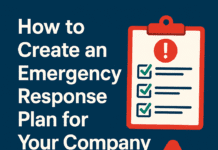
Emergency Planning Ideas for Effective Disaster Management
Disasters are unforeseen events that can wreak havoc on communities, underscoring the critical need for robust emergency planning. From natural calamities like hurricanes and earthquakes to human-induced incidents such as industrial accidents, a well-thought-out disaster management strategy is indispensable.
Introduction to Emergency Planning
In today’s unpredictable world, understanding the essence of emergency planning is crucial. Disaster management involves a series of proactive measures aimed at mitigating the impact of emergencies. Whether it’s safeguarding lives or preserving infrastructure, effective planning is pivotal.
Importance of Disaster Management
The significance of disaster management cannot be overstated. It serves as a shield against chaos and facilitates a structured response during crises. Proper planning not only saves lives but also minimizes the economic and social fallout of disasters.
Understanding Disaster Scenarios
Various types of emergencies require tailored responses. From natural disasters like floods and wildfires to technological mishaps such as chemical spills, each situation demands a unique approach. Conducting thorough risk assessments aids in identifying vulnerabilities and devising appropriate strategies.
Elements of Effective Emergency Planning
An effective emergency plan comprises two fundamental elements: preparedness and response strategies. Preparedness involves laying the groundwork before a disaster strikes, encompassing risk mitigation, resource allocation, and communication protocols. Equally important are response strategies, which dictate actions to be taken during an emergency, ensuring a swift and organized reaction.
Creating a Comprehensive Emergency Plan
Crafting a comprehensive emergency plan involves meticulous detailing. Establishing clear protocols, defining roles and responsibilities, and engaging stakeholders are paramount. Collaboration among various entities – government agencies, community organizations, and businesses – fosters a cohesive response framework.
Implementation and Training
Merely having a plan on paper is insufficient. Regular drills and exercises are vital to assess the plan’s efficacy and familiarize stakeholders with their roles. Additionally, continuous training ensures that personnel are equipped to handle diverse scenarios effectively.
Review and Adaptation
Adaptability lies at the core of effective emergency planning. Periodic reviews, post-incident analyses, and incorporating lessons learned are crucial for continuous improvement. Learning from past incidents empowers communities to refine their strategies and stay ahead of potential risks.
Emergency planning for disaster management involves several key steps to ensure readiness and effective response. Here are some essential ideas:- Risk Assessment and Analysis: Understand the potential disasters that could occur in your area. Evaluate their likelihood and potential impact on infrastructure, people, and resources.
- Create an Emergency Plan: Develop a comprehensive emergency plan that covers various scenarios. This plan should include evacuation routes, designated safe zones, communication strategies, and roles/responsibilities for different team members or departments.
- Establish Communication Protocols: Set up multiple communication channels that work in emergencies, including text alerts, phone trees, social media updates, and a central communication hub for coordination.
- Training and Drills: Regularly conduct training sessions and drills to ensure that everyone knows their roles and is familiar with the emergency procedures. This practice helps streamline response efforts during a real crisis.
- Resource Management: Maintain a well-stocked emergency supply kit with essentials like water, non-perishable food, first aid supplies, flashlights, batteries, etc. Additionally, establish partnerships with suppliers or neighboring communities for additional resources if needed.
- Collaboration and Networking: Collaborate with local authorities, emergency services, NGOs, and community groups to coordinate responses, share resources, and gather support during and after a disaster.
- Continual Review and Improvement: Regularly review and update the emergency plan based on lessons learned from drills, real-life incidents, and changing circumstances. Continual improvement ensures readiness for evolving threats.
- Community Engagement: Educate the community about potential risks, how to prepare for disasters, and what to do during emergencies. Engaged and informed communities are better equipped to respond effectively.
- Special Considerations: Account for vulnerable populations such as elderly, disabled, or non-English speakers in your emergency plan. Have strategies in place to assist these groups during a crisis.
- Post-Disaster Recovery Plan: Develop a recovery plan to restore infrastructure, provide medical assistance, offer counseling services, and assist with long-term rehabilitation after a disaster strikes.
Remember, flexibility is key in emergency planning as each disaster can present unique challenges. Regular updates, practice, and adaptability are essential components of effective disaster management.In conclusion, emergency planning is the cornerstone of effective disaster management. By amalgamating preparedness, swift response mechanisms, and adaptability, communities can navigate crises with resilience.
Emergency Planning and Response
Emergency Planning and Preparedness
Emergency Preparedness Plan for Workplace
FAQs
- How often should emergency plans be reviewed and updated? Regular reviews, at least annually, ensure plans remain relevant and effective.
- What role do individuals play in disaster management? Individuals should familiarize themselves with emergency procedures and contribute to community resilience.
- Why is stakeholder engagement essential in emergency planning? Involving stakeholders ensures a coordinated and comprehensive response.
- Are there templates available for creating emergency plans? Yes, numerous templates are accessible, aiding in structuring emergency plans.
- Can technology enhance emergency planning? Technology plays a pivotal role, enabling better communication and resource management during emergencies.
























